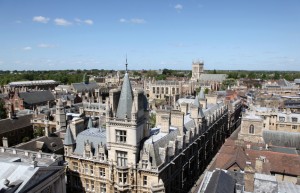
Given its historical importance, Cambridge is one of the most interesting urban centres in the United Kingdom. As such, and through its long history, the city has undergone many changes in key areas such as its population, economy, and industrial base. In this new edition of our ‘The Changing Face of Britain’s Cities’ series, we take a close look at the changes that have taken place in Cambridge in the recent past.
Changing demographics in Cambridge
The earliest human settlement in Cambridge has been traced back to more than 3,500 years ago. However, it was not until 1951 that Cambridge was awarded the city charter, and another 50 years had to go by before the city began to attract large numbers of highly qualified professionals after becoming a national hub for high-technology industries. During the decade of the 2000s, Cambridge’s population growth levels were almost twice as high than the national average, reaching nearly 9 per cent.
Being one of the United Kingdom’s most important student cities, one of the main characteristics of Cambridge’s population is its variable base. During term time, the city is home to up to 130,000 people.
In terms of its age structure, the population of Cambridge is predominantly young, as approximately 40 per cent of all inhabitants are aged 25 years old and under. This is clearly accounted for by the city’s student population, which is in the region of 26,000 people.
The vast majority of Cambridge’s population defines itself as being white (90.1 per cent), including people of white British and Western European origins. The second largest ethnic group in Cambridge is made up by individuals of Chinese origin.
The most densely populated areas are Abbey and Arbury (in the north of the city), although it is expected that within the next few years population growth will be highest in the southern wards of the city, reaching growth levels of up to 12 per cent.
The local population experienced its highest growth levels in the 1930s and 1940s, and it has followed a constant upward trend every year except for 1981. Nowadays, and according to the Cambridgeshire County Council Research Group, it is expected that the city’s population will have increased by 28 per cent in 2031, when the total population is expected to exceed 160,000 people.
The Economy of Cambridge
The latest statistics show that approximately 75 per cent of the working age population in Cambridge is economically active. Because of its status as a research and high-value industry centre, the local unemployment rate is rather low, being 5 per cent in 2010, a figure that is significantly lower than the national average, which is approximately 7 per cent. Since 2001, the local labour market has been characterised by being mostly self-contained, as Cambridge is a major regional employment centre.
According to the latest Annual Survey of Hours and Earnings, the median income in Cambridge is £574.90 a week for male employees and £481.50 for female employees. Approximately 52 per cent of the working population occupies professional or managerial positions. The percentage of manual workers is much lower in Cambridge than in the rest of the United Kingdom, with percentage rates of 27.6 per cent against the national average of 40 per cent.
The city’s economy has evolved from being a medieval market town to becoming one of the leading centres for technology and research industries in the continent. In 2010, there were 5,705 registered business units in Cambridge, of which more than half were small sized enterprises that had between 1 and 4 employees. However, the city is experiencing a continuous decline in office floor space, which may result in a reduction of business start-ups in the long term.
Key industrial sectors in Cambridge
Industry sectors like education and research and development are among the most important in Cambridge, generating revenues that are between 8 to 10 per cent higher than in the rest of the country. The high tech industry (comprised mostly of companies in the aerospace, biotechnology, nanotechnology, electronics, and computing sectors) accounts for 15 per cent of all jobs in the city. Other important industries are health care, software manufacturing, electronic publishing, and electronic manufacturing. Key employers include the city council, Cambridge and Anglia Ruskin universities, Microsoft, Marshall Aerospace, Acorn Computers, Cambridge University Press, Napp Pharmaceutical Group, Eversheds, and Wordpay.
Because of the city’s large number of historical and cultural attractions, the tourist industry plays an important role in the local economy. The latest data show that tourism in Cambridge generates nearly £196 million per yer.
The retail sector in Cambridge has also been continuously growing over the past decade, and currently the city has 700 retail business units.

